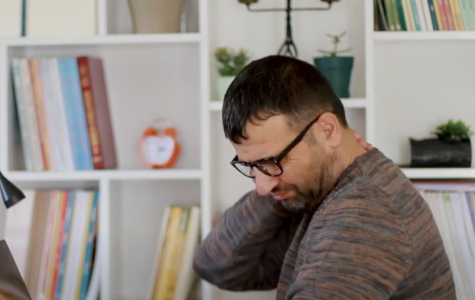Posture problems? Experts explain the habits that could be hurting you
By
Veronica E.
- Replies 0
We’ve all heard that good posture is important—but many people don’t realize just how much daily habits shape it.
It’s not just about standing tall or avoiding a sore back.
The way we sit, bend, scroll, or sleep can quietly impact our joints, muscles, and overall comfort—especially as we age.
Over time, those small patterns can lead to stiffness, pain, or reduced mobility.
But the good news is, you don’t need drastic changes to feel better!
According to physical therapists, a few small adjustments can go a long way.
At The GrayVine, we’re here to help you stay active, confident, and comfortable.
So let’s take a look at six common habits experts say may be hurting your posture—and what you can do to fix them.

Hunching over phones or tablets puts added weight on the neck and shoulders.
This can lead to headaches, jaw pain, and tension in the upper spine.
Try this: Hold devices at eye level, keep your ears aligned with your shoulders, and gently drop your chin to take pressure off your neck.
Poor posture while sitting or relaxing can cause the shoulders to drift forward, weakening support muscles and leading to discomfort.
Try this: Perform a shoulder reset—sit upright, elbows tucked, palms up, and rotate your arms outward before returning to a relaxed position.
Favoring one side can create muscle imbalances in the hips and lower back.
Try this: Sit with both feet flat and knees in line with your hips. If you do cross your legs, be sure to alternate sides regularly.
Constantly tucking your pelvis or tightening your abs can actually cause back pain by disrupting your spine’s natural curve.
Try this: Use the cat-cow stretch to gently arch and round your spine—this helps restore balance and reduce unnecessary tension.
Low seats can overwork the knees and hips, leading to joint strain.
Try this: Adjust your seat so your leg has a soft bend at the bottom of the pedal stroke for better joint protection and comfort.
This common sleep position can strain the neck and back by forcing the spine out of alignment.
Try this: Try sleeping on your side or back using pillows for support. Start with short intervals and gradually ease into the new position.
These small habits may not seem like a big deal—but over time, they can wear on your body.
The good news? With a few mindful adjustments, you can ease tension, reduce stiffness, and protect your mobility for the long run!
Read next: Want to move with ease as you age? Try these 4 easy exercises!

Have you changed a daily habit that helped your posture or eased discomfort? We’d love to hear about it. Drop a comment and share what’s worked for you—you just might help someone else feel better too!
It’s not just about standing tall or avoiding a sore back.
The way we sit, bend, scroll, or sleep can quietly impact our joints, muscles, and overall comfort—especially as we age.
Over time, those small patterns can lead to stiffness, pain, or reduced mobility.
But the good news is, you don’t need drastic changes to feel better!
According to physical therapists, a few small adjustments can go a long way.
At The GrayVine, we’re here to help you stay active, confident, and comfortable.
So let’s take a look at six common habits experts say may be hurting your posture—and what you can do to fix them.

Everyday habits like phone use, sitting posture, and sleep position can quietly impact your posture—small adjustments can make a big difference. Image Source: YouTube / Good Morning America.
1. Tech neck is real—and it hurts
Hunching over phones or tablets puts added weight on the neck and shoulders.
This can lead to headaches, jaw pain, and tension in the upper spine.
Try this: Hold devices at eye level, keep your ears aligned with your shoulders, and gently drop your chin to take pressure off your neck.
2. Rounded shoulders
Poor posture while sitting or relaxing can cause the shoulders to drift forward, weakening support muscles and leading to discomfort.
Try this: Perform a shoulder reset—sit upright, elbows tucked, palms up, and rotate your arms outward before returning to a relaxed position.
Also read: Straighten up: 10 simple fixes that can ease shoulder pain
3. Always crossing the same leg
Favoring one side can create muscle imbalances in the hips and lower back.
Try this: Sit with both feet flat and knees in line with your hips. If you do cross your legs, be sure to alternate sides regularly.
4. Over-bracing your core
Constantly tucking your pelvis or tightening your abs can actually cause back pain by disrupting your spine’s natural curve.
Try this: Use the cat-cow stretch to gently arch and round your spine—this helps restore balance and reduce unnecessary tension.
Also read: Sleeping with 2 pillows could be harmful to your health - find out why experts are warning against it!
5. A bike seat that’s too low
Low seats can overwork the knees and hips, leading to joint strain.
Try this: Adjust your seat so your leg has a soft bend at the bottom of the pedal stroke for better joint protection and comfort.
6. Sleeping on your stomach
This common sleep position can strain the neck and back by forcing the spine out of alignment.
Try this: Try sleeping on your side or back using pillows for support. Start with short intervals and gradually ease into the new position.
These small habits may not seem like a big deal—but over time, they can wear on your body.
The good news? With a few mindful adjustments, you can ease tension, reduce stiffness, and protect your mobility for the long run!
Read next: Want to move with ease as you age? Try these 4 easy exercises!
Key Takeaways
- Hunching over phones or devices—known as "tech neck"—can lead to neck pain, headaches, and jaw tension.
- Common habits like slouching, crossing the same leg repeatedly, or bracing your core too tightly may cause back or shoulder pain.
- Physical therapists recommend small adjustments such as raising phone height, alternating leg positions, and doing light stretches like cat-cow.
- Even seemingly harmless habits like low bike seats or sleeping on your stomach can gradually strain joints and throw off spinal alignment.
Have you changed a daily habit that helped your posture or eased discomfort? We’d love to hear about it. Drop a comment and share what’s worked for you—you just might help someone else feel better too!






